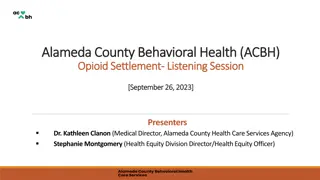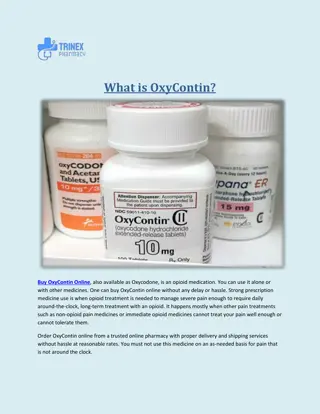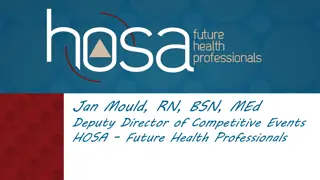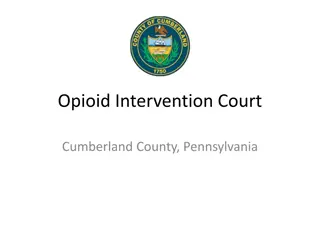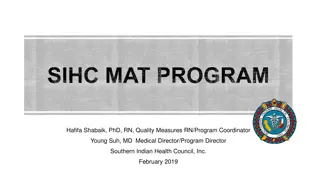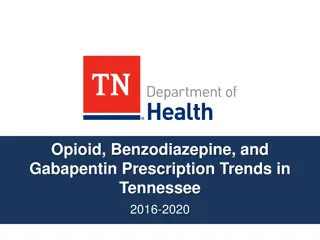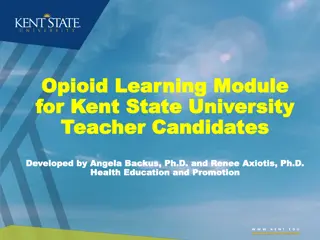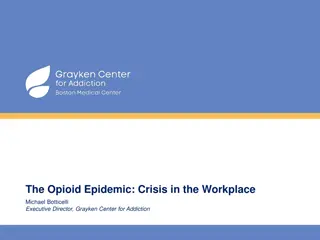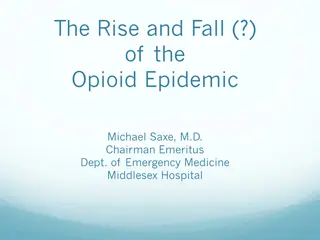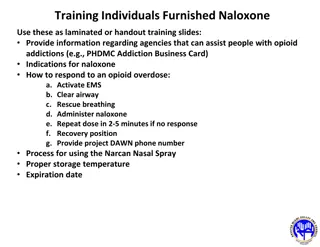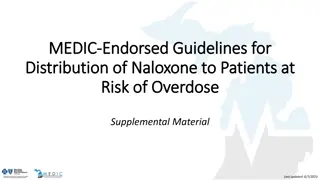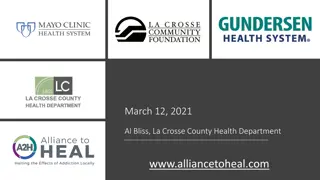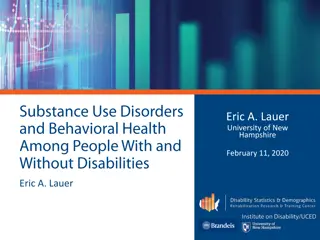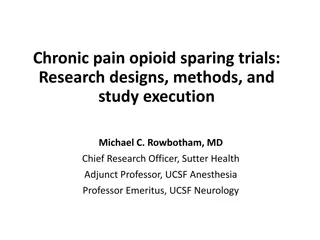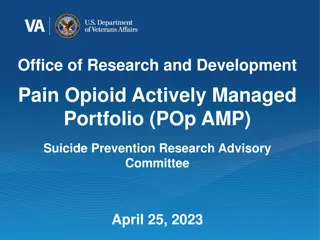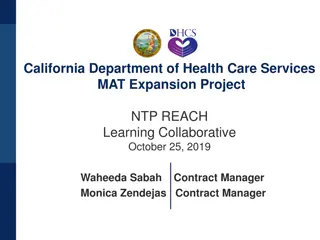Addressing the Opioid Epidemic: Training Opportunities for Behavioral Health Workforce
Funded by USDHHS Health Resources & Services Administration, the grant aims to expand the behavioral health workforce for children affected by opioid and substance use disorders. The program provides training for peer support specialists and paraprofessionals to work in integrated teams. Emphasis is on addressing mental health disorders and substance use among at-risk youth. The grant spans four years.
Download Presentation

Please find below an Image/Link to download the presentation.
The content on the website is provided AS IS for your information and personal use only. It may not be sold, licensed, or shared on other websites without obtaining consent from the author.If you encounter any issues during the download, it is possible that the publisher has removed the file from their server.
You are allowed to download the files provided on this website for personal or commercial use, subject to the condition that they are used lawfully. All files are the property of their respective owners.
The content on the website is provided AS IS for your information and personal use only. It may not be sold, licensed, or shared on other websites without obtaining consent from the author.
E N D
Presentation Transcript
Addressing the Opioid Epidemic: Creating Training Opportunities for the Behavioral Health Workforce SANDY SLATER, PHD, MS SARA CASALI, DSW
Program Staff Sara Casali, Co-Director Sandy Slater, Co-Director Kimberly Payne, Program Coordinator Lisa Adams-Qualls, Instructor Laura Adameak, Instructor Tori Negash, Instructor
Received my PhD in 2005 in the Public Health Sciences with a concentration in Health Policy and Analysis from University of Illinois at Chicago s School of Public Health Primary research interest: to examine how environmental factors and policies influence health-related behavior and health outcomes. Sandy Slater, PhD, MS Research to date focuses on: 1. Physical activity/Inactivity 2. Substance use Multi-disciplinary approach to research
Received my DSW in 2022 from the University of St. Thomas, St. Paul, MN. The program had an emphasis of Teaching as Practice, with a primary focus on preparing graduates for teaching and leadership within Higher Education. Dissertation research focused on Intersectionality in Social Work Education. Sara Casali, DSW, MSW Prior to academia, spent 20 years working in the child welfare system in Milwaukee County. Remains in private practice as a Child Custody and Physical Placement Evaluator and Expert for Family Courts in the area. Currently Director of Field Education for the Department of Social Work at CUWAA
Research vs. HRSA Program Grants Research Grant HRSA Program Grant Proposes to answer a research question Hypothesis-driven Research grants are conducted to find and report new knowledge Primary purpose: expand the health workforce Funds training programs not research activities Includes an evaluation component
Overview of the Grant Funded through USDHHS Health Resources & Services Administration Mission: To improve health outcomes and achieve health equity through access to quality services, a skilled health workforce, and innovative, high-value programs. Purpose of NOFO: To support training programs that expand the number of peer support specialists and other behavioral health-related paraprofessionals who are trained to work in integrated, interprofessional teams in providing services to children whose parents are impacted by opioid use disorders (OUD) and other substance use disorders (SUD), and their family members who are in guardianship roles. Focus is on demonstrating knowledge and understanding of the specific concerns for children, adolescents and transitional aged youth in high need and high demand areas who are at risk for mental health disorders and SUDs. Program funding provided for four years
The Need Opioid use disorder (OUD) and substance use disorder (SUD) continues to impact all individuals across this country regardless of race, gender, and economic background The scope of opioid related deaths has doubled since 2010, and continues to rise Opioid and heroin use rose during 2005 and 2016 and the rate of misuse has more than tripled Opioid-related hospitalizations remains common throughout the state and impacts every community Only one-quarter of individuals that need treatment for OUD/SUD services are able to receive treatment Research highlights that individuals that are low-income and from underserved communities are limited in accessing OUD treatment
Grant Goals Increase the number of paraprofessionals with interprofessional clinical skills to work with individuals with opioid use disorders (OUD) and substance use disorders (SUD). 1.) Increase the number of interprofessional clinically prepared paraprofessionals working with individuals with OUD and SUD through recruitment and financial support for students. 2.) Increase experiences and strengthen clinical opportunities for paraprofessionals working with individuals with OUD and SUD through the provision of experiential learning. 3.)
Grant Objectives Develop and implement an OUD and SUD Certificate Program by September 1, 2020. Train 200 students in an OUD and SUD certificate training program with 50% enrolling in an apprenticeship program by September 1, 2024. 100% of student participants will demonstrate an increase in knowledge and skills needed to provide services to individuals suffering from OUD and/or SUD each year of the grant. Students receive stipends to complete an OUD and SUD certificate training program 90% of students who enroll in an OUD and SUD certificate training program will secure employment in a SUD/OUD/AODA-related position/organization within 6 months of program completion. Develop and implement a registered apprenticeship program
Development of the OIFSP Certificate Program Level 1 Training; One-year certificate program consisting of 3 components covering 145 hours of related instructional time. 3-credit hour course that introduces students to the effects of drugs on the brain and how drugs affect cognition, personality, and behavior. 8-week online course that provides them with the foundational tools to counsel and treat addictive behaviors. 48 hours of supervised experiential learning over the course of 3 months. Each of the following 12 areas must have been performed through Blackboard activities: screening, intake, orientation, assessment, evaluation, and intervention, referral, treatment planning, counseling, crisis intervention, patient education, case management, reporting and record keeping, and consultation with other professionals.
Level 1 Enrollment Target Enrolled Completed Attrition Year 1 45 45 39 6 Year 2 55 55 37 18 Year 3 55 52 NA 6 Year 4 45 NA NA NA TOTAL 200 152 76 30
Student Information STUDENT ASSESSMENTS STUDENT LEVEL 94 92 90 28.7 88 36.2 86 84 82 80 78 35.1 76 Year 1 Year 2 Year 3 Pre-test Post-test Undergraduate Graduate Non-Degree
Student Demographics GENDER LOW-INCOME 90 90 80 80 70 70 60 60 50 50 40 40 30 30 20 20 10 10 0 0 Gender Low-income Male Female Yes No
Student Demographics State Race/Ethnicity 17 22.3 9.6 4.3 53.2 2.1 73.4 17 WI MI Other Unknown Multi-Race AIAN Black White
Student Survey Results Overall Satisfaction Dissatisfied 11% Neither Satisfied nor Dissatisfied 5% Extremely Satisfied 28% Extremely Satisfied Satisfied Neither Satisfied nor Dissatisfied Dissatisfied Satisfied 56%
Impact in Career The sessions were helpful because I work with individuals that have SUD and mental health diagnoses. Has the knowledge you gained from the Opioid Certificate Training Program benefitted you in Allowed me a deeper understanding of opioids and the connection to society. I am able to identify drugs and their uses and the disorders that require them easier. Provided resources for continued learning and providing patient care 17% I have been able to use the skills learned to help understand those populations dealing with this. I work for a FQHC primarily supporting SUD prevention, treatment, and recovery efforts in our community. This certificate broadened my knowledge. 83% Yes No
8 7 6 5 4 3 2 1 0 Social Worker AODA Worker Clinician/Therapist Outreach Worker Public Health Worker Other Primary Discipline Primary Discipline
Supplemental Funding Collaborative effort with local social service agency (Wellpoint) Developing six self-paced online modules Modules will focus on developing skills to provide OUD/SUD treatment via telehealth. Training topics will include: Core trauma informed care (TIC_ priorities Outline the connection between trauma and drug use/abuse Outline factors that diminish and enhance professional capacity
The Registered Apprenticeship Program Apprentice is paid employee Employers are the foundation of every RA program Business Involvement Closes the knowledge and skills gap of apprentices Lots of flexibility for how this is offered Related Instruction Structured on-the-job Training Apprentices receive structured support and mentoring Systematic supervision allows apprentice to meet competencies Performance reviews provide feedback on progression Wage increases as apprentice gains skills Rewards for Skill Gains National Occupational Credential Apprentice receives nationally recognized credential upon completion Ensures employers that individual has the knowledge and skills to meet occupational expectation.
Apprenticeship in the Behavioral Health Field What are the community needs: What occupations address these needs? Business Involvement What topics of learning are needed to be successful in these occupations? Who will deliver the instruction, how will it be delivered and where will it be delivered? Related Instruction Structured on-the-job Training What skills are needed to be proficient in the occupation? What behavioral competencies are required? What will the mentoring support during the apprenticeship look like? What is the entry and exit wage for this occupation, and how often will the apprentice receive wage increases? What is the current process for performance review? Rewards for Skill Gains National Occupational Credential Successful completion=proficiency of core competencies for a specific occupation
Status of Apprenticeships HRSA providing technical assistance from the Institute for American Apprenticeships (IAA) Partnership with Charter Apprenticeships Charter has approved national Registered Apprenticeship standards DOL O*NET Code: Community Health Worker occupation
Student Feedback (Level 1) The Opioid Impacted Family Support grant has truly changed the way that I understand and work with clients suffering from substance abuse disorder. I feel vastly more well-prepared to work with this population and their families. The [training] information was very useful in our day-to-day interactions with our caseload. It answered so many questions and provided us an understanding of how deadly OUD/SUD can be. I ve learnt from this experience that the utility of ones mind is most essential and powerful, yet fragile. The destruction of it for whatever reason due to drugs is indeed catastrophic, however preventable. The grant program provided me with in-depth information, resources, and training that I may not have been able to obtain through the required curriculum. This training was invaluable as I embark into the social work field. It has also helped with building natural support relationships. Where I mentioned them here and there previously, I now focus on these relationships and why they are important. I m utilizing peer supports with all my cases now. Being able to understand the brain make-up and thought patterns of addicts changed my perspectives and approaches for communication. I also learned a new sense of patience and understanding. I ve also been able to pick up on signs of relapse quicker. Whereas before I used to think a client may be having a bad day, I can now tell by body language, eye dilation, coloring, etc. that there may be withdrawal symptoms or signs of current use.
Challenges and Lessons Learned Office of Apprenticeship vs. State Apprenticeship Agency structure Selection and development of apprenticeship standards and occupation codes Short-term solution partner with a National Apprenticeship Standards organization Recruitment of MI students for the certificate program Recruitment of apprenticeship partner organizations Re-evaluated target goals for enrolled registered apprentices (N=100 vs. N=20)
Next Steps Build partnerships with OUD/SUD/AODA organizations in both MI and WI to serve as registered apprenticeship sites for students. Establish registered apprenticeship standards in both MI and WI for the OIFSP certificate program. Enroll additional students in RA programs. Finalize supplemental award funding training. Explore options for sustainability of the OIFSP certificate program. Work with Division of Safety and Professional Standards to address alignment of Level 1 training with SAC-IT credentialing.


